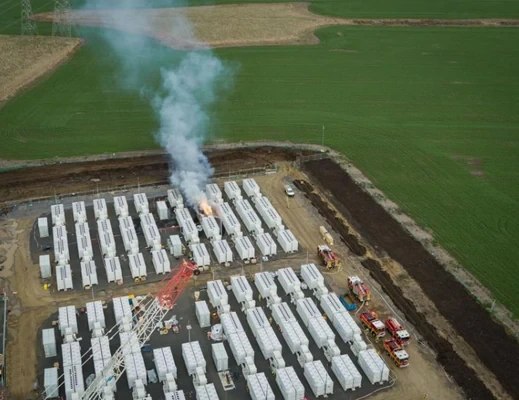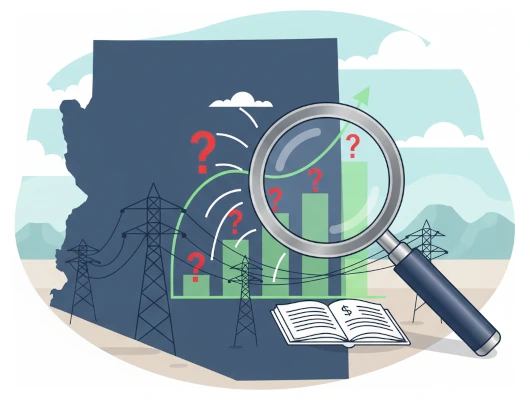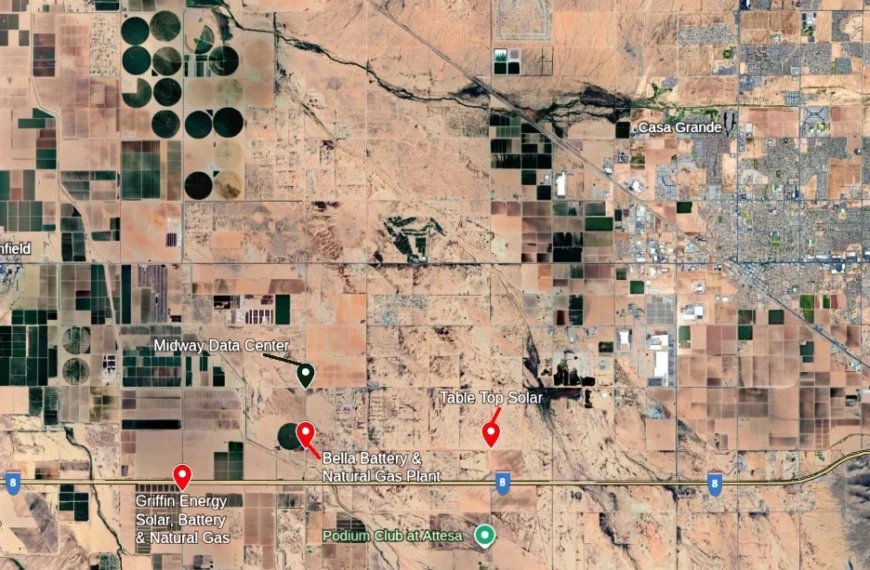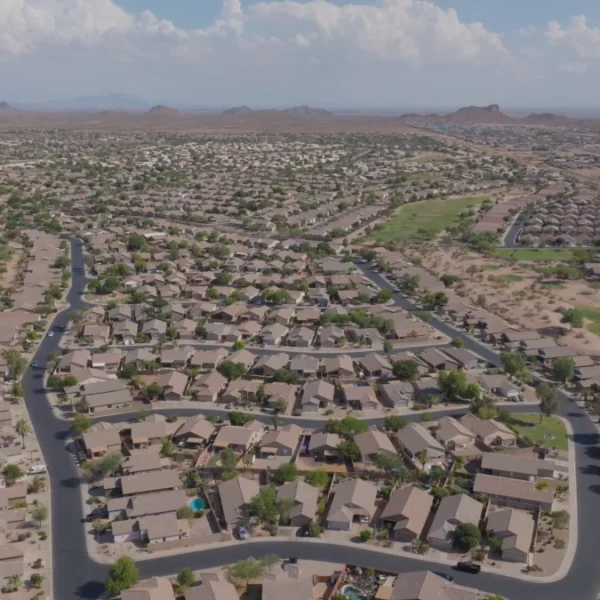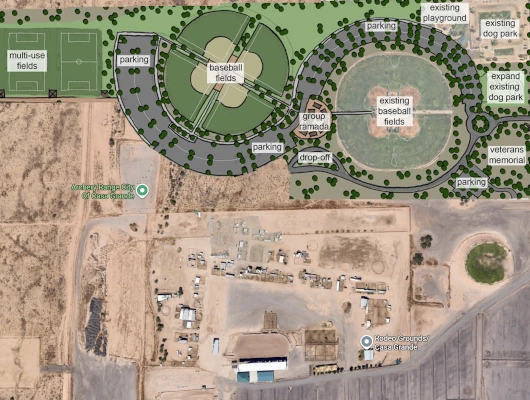Key Points
- 800 MW battery storage project wins Planning Commission approval.
- $750 million project spans 40 acres near Maricopa.
- Site sits near major regional electrical substations.
- Fire safety was a significant topic of discussion.
- Applicant projected $10 million in county tax revenue.
- Commissioners questioned revenue due to battery exemptions under Arizona law.
- Battery can store energy for four hours and support peak demand.
- Facility uses no permanent water service and saves 200 acre-feet annually per applicant.
- Traffic impact minimal with no on-site employees.
- Staff received 17 letters of support (per oral presentation) and one opposition letter.
- Commissioner Mooney cast the sole opposing vote.
- Project now moves to the Board of Supervisors.
The Pinal County Planning and Zoning Commission voted to recommend approval of a 40-acre battery energy storage facility near Maricopa on November 20, 2025. The Cactus Wren Energy Storage project would store up to 800 megawatts of electricity for four hours.
To put that capacity in perspective, Electrical District 3 set a system peak demand record of 280 megawatts on August 7, 2025. The proposed battery facility could store nearly three times that peak demand for four hours. ED3 announced the record during extreme heat when temperatures reached 115 degrees.
The commission forwarded the proposal to the Board of Supervisors with conditional approval. Commissioner Karen Mooney cast the sole opposing vote on each of the three related cases.
Project Location and Specifications
The proposed facility would occupy approximately 40 acres south of Teel Road and west of White & Parker Road in Maricopa, unincorporated Pinal County.

esVolta Development LLC is seeking to rezone the property from General Rural to Industrial (I-3) with a Planned Area Development overlay. The company also requested a comprehensive plan amendment from Moderate Low Density Residential to General Public Facilities Services/Utilities.
The battery energy storage system would include a substation area and internal access roads. A new gen-tie would link the project to existing transmission lines.
The facility would be surrounded by 50-foot landscaped buffers on all sides. These buffers would include native desert plants, deciduous trees, and shrubs to provide visual screening. Seven-foot block walls would enclose the entire perimeter.
Strategic Energy Infrastructure Location
Court Rich of Rose Law Group represented the applicant. He explained the site’s strategic importance to the regional power grid.
“This is like the corner of Main Street and 1st Street, or Main and Main, for electricity in Pinal County,” Rich said. Four major substations operate nearby.

The battery system would capture excess electricity when supply exceeds demand. Utilities could then release that stored energy during peak usage periods.
“What the battery energy storage system allows you to do in this location is to take the energy that’s flowing in and out of those key nodes and hold onto it when it’s cheap or when there’s too much of it on the grid,” Rich explained. “And then SRP will hit a button and it will then disperse it when it’s needed.”
Rich emphasized the importance of proximity to existing substations. “Anywhere else, if you get further away from these substations, then when you’re transmitting the energy, just by physics, a lot of it’s lost, and it becomes much less efficient,” he said.
The site connects directly to Duke and Santa Rosa Switchyards, the WAPA Substation, and the ED3 Substation. These facilities anchor the region’s electrical transmission network.

Tax Revenue Discussion Raises Questions
Commissioner Tom Scott questioned the project’s property tax contributions. The exchange revealed complexities in Arizona’s tax code for battery storage facilities.
Rich stated the $750 million project would generate approximately $10 million in county tax revenue. However, Scott raised concerns about battery exemptions from property taxes.
“We know by the tax code of Arizona that batteries aren’t taxable at all,” Scott said. He indicated the county assessor confirmed batteries are excluded from property tax calculations.
Rich clarified that batteries don’t pay sales tax. However, he maintained they do pay business personal property taxes.
The discussion remained unresolved. Scott noted the battery exemption would reduce the taxable value below the stated $750 million investment.
“I’m just throwing it out here for the public hearing,” Scott said. “Just trying to keep it clean for my citizens I represent there.”
Fire Safety Protocols and Training
Fire safety dominated much of the commission’s discussion. Scott asked about protocols for battery fires after a recent incident in Peoria.
Rich brought fire safety expert Brian Fink to address concerns. Fink spent 38 years with the New York City Fire Department and retired as a battalion chief. He now trains firefighters on battery energy storage facility responses.
The facility will include a fire tank as required by fire code. Rich noted they are working with both Thunderbird Fire District and Maricopa Fire Department.
Fink explained modern response protocols emphasize spatial separation over water application. Containers positioned far enough apart prevent fire spread between units.
“Your best option is not to try to put out the burning container, just protect the exposures,” Fink advised. “Spatial separation is a good alternative to having large amounts of water on the site.”
According to Fink, new 2026 UL standards will require manufacturers to test container spacing. They must ignite entire battery containers with adjacent containers nearby to determine safe distances.
“The code council that I sit on, it’s UL9540 and 9540A, is now going to require in 2026 that testing be done by the manufacturers as to what those spatial separations should be by igniting an entire container of batteries and having containers around it so it could give them a good idea where will the next container be safe if there is a fire in one of the adjoining containers.” Fink explained.
Water Requirements and Peoria Fire Comparison
Scott calculated water needs based on the Peoria battery fire.
“I figured on that one fire that they sprayed out, you know, a half million gallons of water,” Scott said. He expressed concern about citizens’ safety given the remote location’s limited infrastructure.
Fink explained current protocols no longer call for massive water application. Modern response tactics focus on intermittent cooling of adjacent containers.
“The amount of water being applied here is no longer the response tactic,” Fink said regarding the Peoria fire video. “We’re going to maintain a safe standoff distance, monitor the temperatures of the adjacent containers, and we’re just going to keep them cool.”
Fink added that damaged batteries should burn completely. “If the batteries involved, the damaged batteries are allowed to consume themselves, it can’t go back on fire again,” he explained.
Fire & Risk Alliance Presentation to Board of Supervisors
Commissioners mentioned the Board of Supervisors received a detailed fire safety presentation on November 12, 2025. Epic Star Energy brought Fire & Risk Alliance to present battery safety information to the board. The Pinal Post reported on the presentation in detail.
Rich noted his fire expert was from the same firm. “If you want to talk about fire I have with us today a consultant, from Fire Risk Alliance,” Rich said. “They write the book on battery fire safety.”
Fire & Risk Alliance has trained multiple fire departments across Arizona. Representatives sit on commissions that write fire safety regulations for battery storage facilities.
Modified Development Standards
The Planned Area Development overlay modifies standard I-3 industrial zoning requirements. Most development standards remain unchanged from base I-3 zoning.
The primary modification addresses building height. Standard I-3 zoning limits structures to 50 feet. The PAD allows substations and associated equipment to reach 90 feet.
Commissioner Mooney asked about the height exception. She wanted clarification on what would exceed 50 feet besides substation components.
Planner Justin Mullis responded specifically. “Substation and associated equipment and infrastructure may reach a maximum of 90 feet,” he stated.
Rich explained the height exception serves a shared infrastructure purpose. The taller structures are needed for electrical poles in the substation. The project will build poles that ED3 can share, which will save the utility and its customers money.
The PAD restricts permitted uses to energy storage facilities only. All other industrial uses allowed under I-3 zoning would be prohibited.
Pre-Annexation Agreement with City of Maricopa
The project is finalizing a pre-annexation development agreement with the City of Maricopa. Rich expressed enthusiasm about this partnership.
“We’re working on a pre-annexation development agreement with the City of Maricopa, which we’re really excited about, and we’re finalizing that,” Rich announced during his presentation.
Utility Support Letters
Salt River Project submitted a letter supporting the Cactus Wren project. SRP serves approximately 90,000 Pinal County residents, representing roughly 20 percent of the county population.
“SRP serves more than 2 million residents across central Arizona, including over 90,000 in Pinal County,” the utility stated. “We anticipate approximately 12% annual energy growth in Pinal County over the next decade.”
SRP emphasized battery storage’s critical role in grid reliability. “Battery storage is critical to grid reliability. It provides flexible capacity, reduces reliance on costly wholesale markets, and ensures adequate supply during peak demand,” the letter stated. “These resources help prevent shortages that could lead to blackouts.”
The utility urged approval before their board could finalize agreements. “We respectfully urge the Commission to approve this project, which will strengthen the regional grid and help ensure safe, reliable power for Pinal County and beyond,” SRP wrote.
Electrical District 3 also provided strong support.
“ED3 will directly benefit from shared electric line infrastructure that esVolta will construct,” the utility stated. “Coordination between ED3 and esVolta has already begun and is ongoing. ED3 expects this shared infrastructure and ancillary services provided by the BESS system to be a benefit to Pinal County and ED3’s customers.”
ED3 called the location ideal. The utility emphasized approval’s importance to continued coordination.
Public Comments
Laurie Fuller of Thunderbird Farms was the only person to speak during public comment. She learned about the project only by reading the Friday agenda before the Wednesday meeting.
“When these projects happen in unincorporated Pinal County and they only are required to send a notice within 1200 feet of something, quite often we don’t hear about it, at all,” Fuller said.
She noted other battery facilities coming to Hidden Valley. Fuller attended information sessions for two additional projects.
“I have attended two information sessions by two additional battery energy storage systems that are coming up in Hidden Valley,” Fuller said. “One is Horseshoe. It is going to be 159 acres and it’s just a few miles from this one. There is a new, another one coming up called Hazy Peak.”
Fuller questioned Rich’s characterization of Cactus Wren as small and isolated. “If the presenter is saying this is the only one and it’s very small in the area, there’s two more upcoming,” she said.
Traffic Impact Analysis
Traffic engineer Paul Basha prepared an analysis showing that the current comprehensive plan designation allows 3.5 homes per acre on the 40-acre site. Rich noted that residential development would generate approximately 1,400 vehicle trips per day. The battery facility will have no permanent on-site employees, with only one to two maintenance workers visiting periodically for routine maintenance.
Water Resource Conservation
The project requires no permanent water service. A water truck will provide water only if needed for occasional maintenance.
HDR Engineering confirmed no wastewater infrastructure would be necessary. “Since the site will be unmanned there are no needs to provide wastewater infrastructure in the future,” engineer Christopher Tynes wrote.
Rich noted the facility will save approximately 200 acre-feet of water annually. This represents water that would otherwise serve the 140 homes allowed under current zoning.
Community Support and Opposition
Staff received 17 letters supporting the project. The Pinal Alliance for Economic Growth endorsed the proposal. ED3 and SRP submitted formal support letters.
Fourteen county residents wrote in favor. Two of those supporters are immediate neighbors to the property. The Dugan family lives approximately 2,500 feet south of the site. The Grewing family resides about 3,000 to 4,000 feet north.
Staff received one letter of opposition. That letter expressed concerns about energy development’s cumulative impact. It questioned effects on the desert landscape.
Rich emphasized neighbor support as evidence of minimal community impact. “What really, I think, underscores how limited the intrusion or what this means to the neighborhood is that we have two letters of support from two of the nearest neighbors to the property,” he said.
Surrounding Development and Land Use
The Nissan Technical Center sits directly east across White & Parker Road. That 4,029-acre facility has operated since 1985 under CI-1 zoning.
The closest residence to the proposed site is approximately half a mile south. Surrounding parcels include active and inactive agricultural land mixed with natural desert landscape.
The surrounding area was approved decades ago for master planned community development. However, much of that land remains undeveloped.
Rich noted existing electrical infrastructure characterizes the area. “There’s already these sort of significant electrical kind of passive uses in the area with these substations and these transmission lines,” he said.
The site’s current comprehensive plan designation allows 1 to 3.5 dwelling units per acre. This equates to a potential 140 homes on the 40-acre property.
Battery Energy Storage System Functionality
Commissioner Bryan Hartman sought clarification on how the 800-megawatt system works. He understood it helps flatten energy demand curves.
Rich confirmed utilities use batteries multiple ways. They can arbitrage energy prices by buying cheap power for later sale. They can also provide instant peak capacity.
“When batteries are on the grid by themselves, they can absorb any energy that’s on the transmission system at that time,” Rich explained.
SRP could buy electricity when prices drop and store it for expensive afternoon hours. “It’s a lot cheaper for the rate payers if they use it just to arbitrage the energy prices,” Rich said.
Batteries also activate immediately unlike gas-fired plants. “Some of the gas-fired power plants might take a few minutes to ramp up,” Rich noted. “These are just on. Like, when you need it, it just boom.”
Hartman expressed enthusiasm for the technology. “I’d like to see more of it,” he said.
Commissioner Scott’s Clarification on Energy Sources
Scott asked where the excess battery energy originates. Rich explained the facility could store any electricity flowing through the nearby transmission lines.
The battery system doesn’t generate power itself. It captures electricity from various sources on the regional grid.
SRP, APS, and other utilities transmit power through the substations near the site. Solar farms throughout the region feed electricity into those same transmission lines.
Solar power plays a role as one generation source, Rich confirmed. However, the battery can store electricity regardless of its original source.
Commission Vote and Next Steps
The commission forwarded three recommendations to the Board of Supervisors. These included the comprehensive plan amendment (PZ-PA-005-25), the rezoning (PZ-016-25), and the PAD overlay (PZ-PD-010-25).
Commissioner Mooney voted against all three items. All other commissioners present voted in favor.
The Board of Supervisors will consider the applications in a future meeting. SRP indicated their board needs zoning certainty by December to proceed with contract negotiations.

